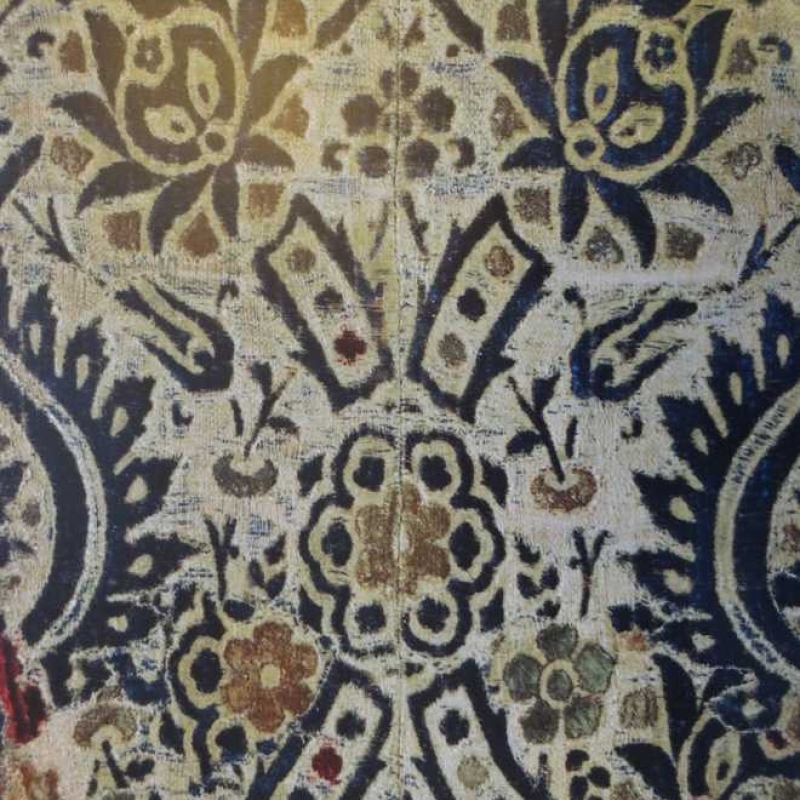Not a great many velvets has survived, except in select public collections. Private collections of the fabric are rather rare. Prof B.N. Goswamy writes about the significance of velvets in Mughal courts and what he learnt about silks through an exhibition. (In pic: Fragment of a tent. Velvet with supplementary weft patterning; Photo courtesy: The Tribune)
This article appeared originally in The Tribune, Chandigarh and is reproduced here with permission.
They begin to prepare for this feast (the Emperor Aurangzeb’s birthday celebrations), the seventh of September, about two months before it begins. The first thing they do is to cover the two great Courts overhead, from the middle of each Court to the Hall, which is open upon three sides. The pavilions that cover these two void places, are purple velvet, embroidered with gold, and so weighty that the posts which sustain them are as big as the mast of a ship some thirty, some forty foot high. There are thirty eight of the posts to uphold the tent in the first court and those next the hall are plated with gold as thick as a ducket.
— Jean-Baptiste Tavernier, ca. 1665
At the heart of this account of indescribable luxury—and that too relating to the reign of Aurangzeb, whose image in the popular mind is that of a frugal, self-denying monarch—is that cloth of luxury: velvet, embroidered with gold. There may be some exaggeration in this account but, by and large, Tavernier, the French gem merchant who made several voyages to Persia and India between 1630 and 1668, is known to have been a sharp observer of things material, making notes about things he personally was a witness to. When he was at the court of the Ottoman Sultan, Murad IV, he recorded having seen similar opulence, and spoke of the coverings of the royal throne. “The most magnificent of all those coverings,” he wrote, “is of a black velvet with an embroidery of great pearls whereof some are long, and others round, and in the forms of buttons. There is another (covering) of white velvet, set out with an embroidery of rubies and emeralds, most whereof are set in bezels, or collets, the better to keep them in….”
Also read | Velvet Weaving in India

I know remarkably little about velvets except of course the feel of the fabric, and even when I read a technical definition of it—“a plush pile fabric created by supplementary warp threads looped above a foundation weave; the threads can be cut (creating pile), uncut (creating loops), or woven into the foundation (creating voids)”—I continue to retain most of my ignorance. But I also continue to be intrigued by the fascination for it, and the high value that has, throughout history, remained attached to it. Even the titles of books written on or around velvets conjure up images of great luxury. Consider, for instance, titles like ‘The Crescent and the Rose: Imperial Ottoman Silks and Velvets’, ‘Woven from the Soul, Spun from the Heart: Textile Arts of Safavid and Qajar Iran’, or ‘Woven Luxuries’. It is clear that, at one time, certainly in royal circles, velvets were in extensive use. They served, as has been noted, “as floor coverings, wall hangings, canopies, curtains, tent panels, throne covers, bolsters, cushions, spreads, covers for imperial insignia such as banners and standards, and envelopes for diplomatic and imperial communication.” In the paintings of India, from the Shah Jahan period Padshahnama, for instance, one sees them, like in the folio of which a detail is reproduced here, everywhere: draped—there are two if not three layers of them—over the filigreed marble balustrade fronting the high place where the emperor sits greeting his sons, while the nobility and courtiers and ambassadors and petitioners stand respectfully below; making up the rolled up curtain over the window behind the royal back; wrapped round the imperial insignia mounted on tall poles at right; possibly also on the only partially visible canopy over the emperor’s head. Surely when the emperor travelled away from the capital on hunting trips or military campaigns, and virtual cities made up of tents were set up, great velvets must have made for dazzling sights, for apparently they were obviously in constant use, as contemporary sources keep informing us.
Photos | Antique Velvet Artefacts

Silk clearly was the basic material, and one knows, both in the words of Abu’l Fazl, the great chronicler of the Akbari court, and of travellers who came long distances and had the opportunity of seeing for themselves the magnificence of the Mughal courts that they only heard of, that great workshops had been set up. The entire process, long and complex as it was, was handled by specialists: “from the raising of silkworms to the processing, spinning and dyeing of silk threads, and from the manufacturing of metal threads to the designing and finally the weaving of fabrics”, as Qamar Adamjee has noted.

Not a great many velvets have survived except in selected public collections, and private collections of these are rather rare. When one such collection, owned by a New York based couple—Rina Indictor, a PhD in comparative literature, and her husband, Norman, retired professor of Chemistry—was on view in San Francisco, it was an occasion to celebrate. But it was also an occasion to learn. I, for instance, learnt from the brochure produced to accompany the exhibition, at least four things: One, that ‘a silk strand is stronger than a similarly sized steel wire’; two, that ‘silk is excreted by silkworms to make cocoons that need to last, on average, two weeks, and yet it can last centuries’; three, that ‘one strand of silk unrolled from a cocoon can be more than a third of mile in length’; and, four, that ‘prior to World War I, printed US currency had silk fibres distributed throughout the currency note’.
I wonder how many people know this.
This article has been republished as part of an ongoing series Art N Soul from The Tribune.













